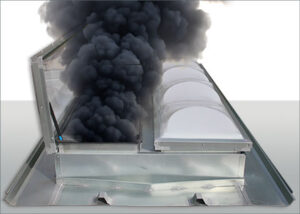Introduction to Smoke Vent Systems
In the construction and building-safety world, smoke vent systems are extremely important. These systems do more than just comply with regulations, they are essential for keeping people safe and protecting the building’s structure. If you’re a general contractor, it’s vital to grasp the details of these systems to successfully finish any project.
The Importance of Smoke Vent Systems
Smoke vent systems play a pivotal role in:
-
- Facilitating Safe Evacuation: In the event of a fire, smoke can quickly fill up spaces, making visibility almost zero. Smoke vent systems help clear smoke, allowing occupants to see exit routes clearly.
- Aiding Firefighters: By clearing smoke, these systems provide firefighters with better visibility, enabling them to tackle the fire more effectively.
- Preserving Property: Excessive smoke can cause damage to property. By venting out the smoke, the damage can be minimized.

Types of Smoke Vent Operation
There are several types of smoke vent systems available, each designed to cater to different building needs. These are the most popular metal roof smoke vent systems:
-
- UL Listed Fusible Link: These smoke hatches utilize automatic UL-Listed Fusible Links which operate at a preset temperature. Replacement links are low-cost, readily available, and easy to install. Here’s a sample of UL Listed Fusible Link activation temperatures (F): 165, 212, 286, 370, 520
- McCabe Resettable Link: McCabe Links offer thermal / electronic activation of release. This provides flexible integration with existing fire safety equipment and simplifies required annual testing process because no cutting is required. McCabe Links can be electronically activated from ground level.
Choosing the Right System for Your Project
As a general contractor, it’s essential to choose the right smoke vent system for your project. Here are some considerations:
-
- Building Size and Type: Larger buildings or those with complex designs might require more advanced systems.
- Budget: While safety is paramount, budget constraints can influence the choice of system.
- Local Regulations: Ensure the chosen system complies with local building and safety regulations.
Maintenance and Regular Checks
A smoke vent system’s efficacy is only as good as its maintenance. Regular checks and maintenance are crucial:
-
- Monthly Checks: Ensure all components free from dirt and grime and check for signs of rust or corrosion.
- Annual Maintenance: This involves a more thorough check. Manual open tests should preformed annually ensuring all parts are in optimal condition.
- Immediate Addressal of Issues: Any issues detected should be addressed immediately to ensure the system’s effectiveness.
Conclusion
Smoke vent systems are an integral part of modern construction. They ensure the safety of occupants, assist firefighters, and minimize property damage. As general contractors, understanding and implementing the right system is not just a regulatory requirement but a responsibility towards ensuring safety.



